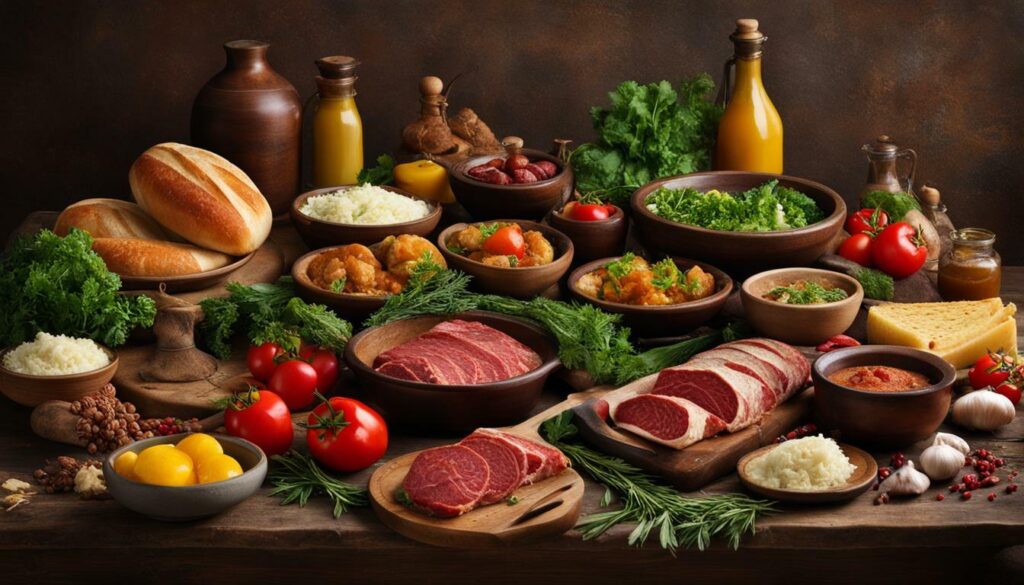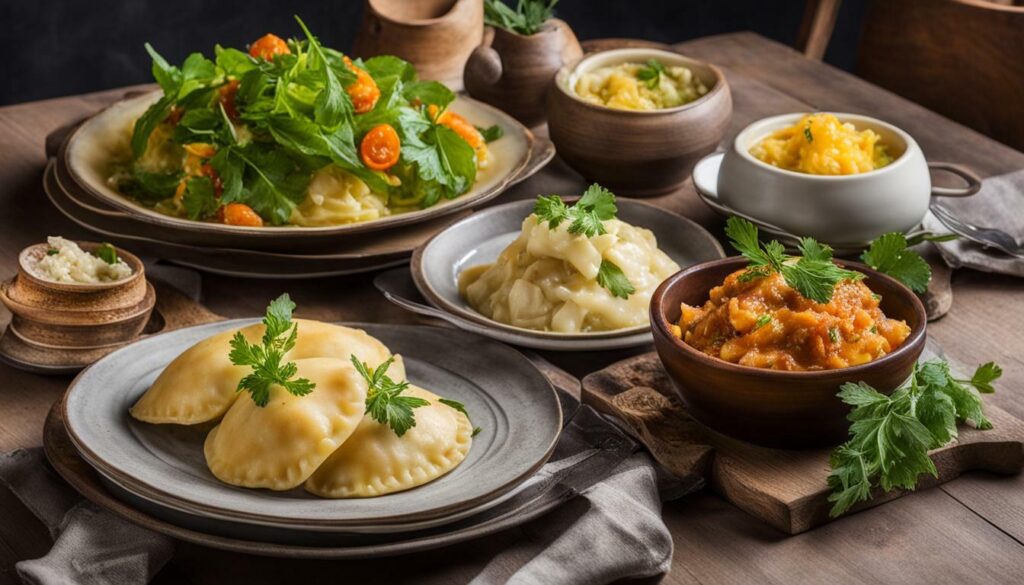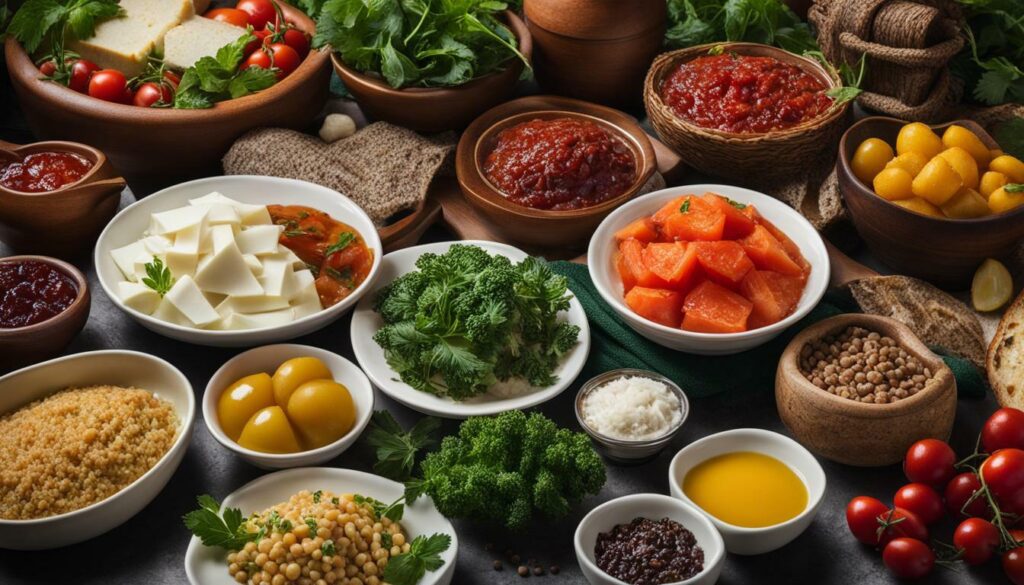Eastern Europe has a rich culinary heritage, with its past and present diets reflecting a complex tapestry of history, culture, and influences. The history of food in Eastern Europe is a fascinating journey that showcases the region’s unique traditions and culinary practices.
Key Takeaways:
- The past and present diets of Eastern Europe are shaped by a rich history and diverse cultural influences.
- Traditional foods in Eastern Europe have been passed down through generations, preserving unique recipes and cooking techniques.
- The evolution of East European diets over time has been influenced by historical events and cultural exchanges with neighbouring countries.
- Staple foods in Eastern Europe form the foundation of the region’s cuisine, with key ingredients and dishes commonly consumed.
- Modern-day cuisines in Eastern Europe have emerged, showcasing popular dishes and culinary trends.
Traditional East European Foods and Culinary Traditions
Traditional East European foods are the cornerstone of the region’s culinary tradition, with recipes and techniques being preserved and passed down through generations. These dishes reflect the rich cultural heritage and diverse influences that have shaped Eastern European cuisine over hundreds of years.
One of the most iconic traditional foods in Eastern Europe is pierogi, a type of dumpling filled with various ingredients such as potato, cheese, meat, or fruit. These delicious parcels are usually boiled or fried and can be served as a main course or dessert. Pierogi are a beloved dish in countries like Poland, Ukraine, and Russia, and are often enjoyed with sour cream or melted butter.
Another staple of Eastern European cuisine is borscht, a hearty beetroot soup that is commonly consumed in countries like Ukraine and Russia. It is known for its vibrant red colour and rich flavour, often enhanced with ingredients such as cabbage, potatoes, and dill. Borscht is often served with a dollop of sour cream and a slice of dark rye bread, creating a wholesome and comforting meal.
One cannot discuss traditional East European foods without mentioning sauerkraut and kielbasa, two ingredients that are synonymous with the region. Sauerkraut, fermented cabbage, adds a tangy and sour note to many dishes and is a popular accompaniment to sausages like kielbasa. These smoky and savoury sausages are made with a blend of pork, beef, or veal, seasoned with garlic, marjoram, and other spices. They are often grilled, pan-fried, or boiled, and are enjoyed on their own or as part of a hearty meal.
Traditional East European Recipes
Here are a few traditional East European recipes that you can try at home:
- Székely Goulash – A Hungarian dish made with pork, sauerkraut, and paprika, cooked until tender and served with dumplings.
- Chicken Kyiv – A Ukrainian speciality consisting of chicken breast stuffed with garlic butter, breaded, and fried until golden brown.
- Langos – A popular street food in Hungary, langos is a deep-fried dough topped with sour cream, cheese, and garlic.
These recipes offer a glimpse into the diverse and delicious world of Eastern European cuisine, where traditional flavours are celebrated and enjoyed.

| Country | Traditional Dish |
|---|---|
| Poland | Pierogi |
| Russia | Borscht |
| Ukraine | Sauerkraut and Kielbasa |
| Hungary | Székely Goulash |
Evolution of East European Diets over Time
The diets of Eastern Europe have undergone significant changes over time, influenced by historical events, societal shifts, and cultural exchanges. Traditional diets in Eastern Europe were characterized by the consumption of locally available foods and culinary techniques passed down through generations. However, with the advent of industrialization and globalization, the region experienced a shift towards more modern and diverse dietary patterns.
Historically, Eastern European diets were heavily influenced by the agrarian lifestyle and the availability of seasonal produce. Crops such as wheat, barley, and rye formed the basis of staple foods, including bread, porridge, and fermented beverages. Animal products, such as meat and dairy, were also prominent in traditional diets, providing essential nutrients and protein.
However, as Eastern Europe underwent economic and political transformations, dietary patterns began to change. The introduction of new technologies and transportation systems allowed for the importation of previously unavailable foods, expanding the range of choices for Eastern European consumers. This led to an increased consumption of processed foods, refined sugars, and vegetable oils, which have been associated with adverse health outcomes.
Despite these changes, Eastern European cuisines continue to reflect the region’s rich culinary heritage. Traditional dishes such as borscht, pierogi, and goulash remain popular, showcasing the unique flavours and ingredients of Eastern European cuisine. Additionally, there has been a growing movement towards rediscovering and promoting traditional dietary practices in recent years, emphasizing the importance of locally sourced, seasonal ingredients and traditional cooking methods.

Overall, the evolution of East European diets highlights the complex interplay between historical, cultural, and economic factors. While modernization has brought about dietary changes, there is a renewed interest in preserving traditional eating habits and promoting healthier food choices. By understanding the historical context of Eastern European diets and embracing a balanced approach to nutrition, individuals can celebrate the region’s culinary heritage while maintaining optimal health.
| Traditional Eastern European Diet | Modern Eastern European Diet |
|---|---|
| – Emphasis on locally sourced, seasonal ingredients | – Increased consumption of processed foods |
| – High consumption of whole grains and vegetables | – Greater reliance on refined sugars and vegetable oils |
| – Incorporation of fermented foods | – Introduction of convenience foods |
| – Limited consumption of red meat | – Increased consumption of processed meats |
Cultural Influences on East European Diets
The diets of Eastern Europe have been greatly influenced by cultural interactions and exchanges with neighbouring countries and communities. Throughout history, Eastern European food culture has evolved through a combination of traditional practices and external influences. These cultural influences have played a significant role in shaping the dietary practices of the region, resulting in a rich and diverse culinary heritage.
One of the key factors contributing to the cultural influences on East European diets is the geographical proximity to other countries. Eastern Europe has been a melting pot of different cultures, with various civilizations leaving their mark on the region’s food culture. For example, the Ottoman Empire introduced foods like kebabs and baklava, which are now deeply rooted in Eastern European cuisine.
The influences of neighbouring countries can also be seen in the ingredients and cooking techniques used in Eastern European dishes. For instance, the use of sour cream in many Eastern European recipes can be traced back to the influence of Russian cuisine. Similarly, the use of sauerkraut and pickled vegetables in dishes can be attributed to the culinary traditions of Central and Northern European countries.
“Food is a reflection of culture, and Eastern European cuisine is a testament to the region’s vibrant history and diverse heritage. The cultural influences on East European diets have created a unique fusion of flavors and culinary traditions.”
Eastern European Food Culture
The cultural influences on East European diets have also shaped the way food is prepared, consumed, and celebrated in the region. Food holds a significant place in Eastern European culture, with communal meals and festive gatherings playing a central role in social interactions. Traditional dishes are often prepared with love and care, using locally sourced ingredients and age-old recipes that have been passed down through generations.
Eastern European dietary practices are characterized by a balance of hearty and wholesome foods. Staples such as potatoes, grains, and dairy products form the foundation of many traditional dishes. Fermented foods like sauerkraut and pickles are also commonly consumed, known for their probiotic benefits.
East European Dietary Practices
While cultural influences have enriched East European food culture, it is essential to recognize the potential health implications of traditional dietary practices. Recent studies have shown that certain components of the traditional diet, such as high consumption of lard, can contribute to increased risks of all-cause and cardiovascular disease mortality. On the other hand, the consumption of preserved fruits and vegetables has been associated with lower risks of mortality.
Overall, a balanced approach to Eastern European dietary practices is crucial. Recognizing the cultural significance of traditional foods while incorporating healthier choices can help promote better health outcomes in the region. Public health nutritional interventions should aim to strike a balance between preserving cultural heritage and improving dietary practices, ensuring that future generations can enjoy the rich flavours of Eastern European cuisines while maintaining good health.

Eastern European diets rely heavily on certain staple foods that are central to the culinary traditions of the region. These foods have been a part of Eastern European food culture for centuries, providing sustenance and flavour to the local cuisine. From hearty soups to savoury stews, these staple foods form the foundation of Eastern European nutrition.
One such staple food in Eastern Europe is potatoes. Potatoes are a versatile ingredient that can be prepared in various ways, including mashed, boiled, or fried. They are commonly used in traditional dishes like pierogi, a type of dumpling, and borscht, a beet soup. The humble potato is not only a source of carbohydrates but also provides essential vitamins and minerals.
Another staple food in Eastern Europe is cabbage. Cabbage is a prominent ingredient in dishes such as sauerkraut, fermented cabbage, and cabbage rolls. It is a rich source of dietary fibre and vitamin C, making it a nutritious addition to the Eastern European diet.
| Staple Foods | Nutritional Benefits |
|---|---|
| Potatoes | Source of carbohydrates, vitamins, and minerals |
| Cabbage | Rich in dietary fibre and vitamin C |
Other staple foods in Eastern Europe include grains like rye and barley, which are used to make bread and porridge. These grains provide a good source of energy and are often consumed alongside hearty meat dishes like goulash and schnitzel. Eastern Europeans also rely on dairy products such as cheese and yoghurt, which are used in various sweet and savoury recipes.
Eastern European food culture celebrates these staple foods and their role in shaping the region’s culinary identity. Although modern-day cuisines in Eastern Europe have evolved and incorporated new ingredients and flavours, these staple foods continue to play an essential role in traditional dishes.

Here are a few traditional Eastern European recipes that showcase the staple foods mentioned above:
- Pierogi: These dumplings are typically filled with mashed potatoes and cheese or sauerkraut. They are often served with sour cream and can be boiled or fried.
- Borscht: This beet soup is a beloved dish across Eastern Europe. It is made using beets, cabbage, potatoes, and other vegetables, and often garnished with sour cream.
- Sauerkraut: Fermented cabbage is a common accompaniment to many Eastern European dishes. It can be enjoyed on its own or as a side dish.
These recipes showcase the diverse flavours and textures that staple foods bring to Eastern European cuisine. Whether you’re a fan of hearty comfort food or looking to explore new culinary traditions, Eastern European cuisine offers a rich and flavorful experience.
Modern Day Cuisines in Eastern Europe
While traditional recipes are still cherished, Eastern Europe has also seen the emergence of modern-day cuisines that blend traditional flavours with contemporary techniques. The region’s rich culinary history and cultural diversity have paved the way for innovative and exciting dishes that captivate the taste buds of locals and tourists alike.
One popular example of modern East European cuisine is the fusion of traditional ingredients and international influences. Chefs have been experimenting with combinations of flavours from different countries, resulting in unique dishes that reflect the multicultural nature of Eastern Europe. For instance, you might find a Russian-inspired borscht soup infused with Chinese spices, or a Polish pierogi dish with a Mediterranean twist.
To meet the demands of health-conscious diners, many restaurants in Eastern Europe now offer lighter and healthier options on their menus. Dishes that incorporate fresh vegetables, lean meats, and alternative grains have gained popularity, catering to those seeking a nutritious and balanced meal. For instance, a traditional cabbage roll might be replaced with a vegetarian version made with quinoa and stuffed with a medley of roasted vegetables.
Furthermore, Eastern Europe has embraced the rise of street food culture, with bustling food markets and stalls offering a wide variety of delicious and affordable options. This culinary trend allows locals and visitors to experience the vibrant flavours of the region in a more casual and accessible way. From savoury stuffed pastries to grilled meats marinated in aromatic spices, street food in Eastern Europe offers a tantalizing taste adventure.
Sample Dish: Smoked Salmon And Dill Bruschetta
“Eastern European cuisine has evolved over the years, adapting to modern tastes and preferences. One popular dish that showcases this fusion of tradition and innovation is the Smoked Salmon & Dill Bruschetta. This delightful appetizer combines the classic flavors of dill, a staple herb in Eastern European cooking, with the smoky richness of salmon. The creamy texture of the salmon pairs perfectly with the crunch of the toasted bread, creating a harmonious balance of flavors. It’s a prime example of how Eastern European cuisine continues to evolve while staying true to its roots.”
| Ingredients | Instructions |
|---|---|
|
|
With its blend of tradition and innovation, Eastern European cuisine continues to captivate food enthusiasts around the world. From reinvented classics to exciting flavour combinations, the modern-day cuisines of Eastern Europe offer a delightful culinary journey that celebrates the region’s rich history and cultural heritage.

A study examining the relationship between historical diets in Eastern Europe and mortality rates sheds light on the potential health implications of traditional eating habits in the region. Data from the Health, Alcohol and Psychosocial factors in the Eastern Europe prospective cohort reveals interesting findings regarding the impact of traditional Eastern European diets on all-cause, cardiovascular disease (CVD), and cancer mortality rates.
The study, which included participants from Russia, Poland, and the Czech Republic, constructed a traditional Eastern European diet score (EEDS) based on food frequency questionnaire data. The results showed that participants with high adherence to the traditional diet had a higher risk of all-cause and CVD mortality compared to those with low adherence. Cancer mortality, however, was only significantly associated with the traditional diet in Poland.
Further analysis of the data highlighted specific components of the traditional diet that played a role in mortality outcomes. High consumption of lard, a common ingredient in Eastern European cuisine, was positively related to all three mortality outcomes. On the other hand, preserved fruit and vegetable consumption showed inverse associations, suggesting a potential protective effect against mortality.
This study underscores the potential impact of traditional eating habits on health outcomes in Eastern Europe, particularly in relation to high CVD mortality rates. It emphasizes the need for public health interventions to address the dietary patterns of the region. By promoting healthier food choices and discouraging the overconsumption of certain high-risk foods, such as lard, it is possible to improve the overall health and well-being of the Eastern European population.

- A study examining historical diets and mortality rates in Eastern Europe reveals insights into the potential health implications of traditional eating habits.
- Data from the study shows that high adherence to the traditional Eastern European diet is associated with higher risks of all-cause and cardiovascular disease mortality.
- Cancer mortality is significantly associated with the traditional diet in Poland.
- The study highlights the positive relationship between high consumption of lard and all three mortality outcomes, while preserved fruit and vegetable consumption shows inverse associations.
- The findings emphasize the need for public health interventions to promote healthier dietary practices in Eastern Europe and reduce high mortality rates.
| Mortality Outcomes | Risk Factors |
|---|---|
| All-Cause Mortality | High adherence to traditional Eastern European diet |
| Cardiovascular Disease Mortality | High adherence to traditional Eastern European diet, high consumption of lard |
| Cancer Mortality | Significantly associated with traditional Eastern European diet in Poland |
Impact of Traditional Diets on Health
The study reveals that adherence to traditional diets in Eastern Europe may contribute to poor health outcomes, particularly in relation to cardiovascular disease and overall mortality. A comprehensive analysis of data from the Health, Alcohol and Psychosocial factors in the Eastern Europe prospective cohort has shed light on the link between traditional dietary patterns and mortality rates across the region. The findings indicate that individuals with high adherence to the Eastern European diet are at a higher risk of all-cause and cardiovascular disease mortality when compared to those with low adherence.
It is worth noting that the study focused on three countries in Eastern Europe – Russia, Poland, and the Czech Republic. The traditional Eastern European diet score (EEDS) was developed by evaluating participants’ responses to a food frequency questionnaire. The score takes into account various components of the traditional diet, including the consumption of lard, preserved fruits, and vegetables.
Specific components of the traditional diet, such as high consumption of lard, were positively related to all three mortality outcomes, while preserved fruit and vegetable consumption showed inverse associations.
This suggests that the consumption of certain traditional foods in Eastern Europe may play a role in influencing health outcomes. The study highlights the need for public health nutritional interventions in the region, aimed at promoting healthier dietary practices and mitigating the risk of cardiovascular disease and overall mortality.
| Traditional Eastern European Diet Components | Association with Mortality |
|---|---|
| High consumption of lard | Positively related to all-cause and cardiovascular disease mortality |
| Preserved fruit and vegetable consumption | Inverse association with all-cause and cardiovascular disease mortality |
These findings provide valuable insights into the impact of traditional diets on health in Eastern Europe. By recognizing the specific dietary factors that contribute to poor health outcomes, public health initiatives can be tailored to address these issues effectively. It is crucial to promote a balanced approach to dietary practices in the region, encouraging the consumption of nutrient-rich foods while minimizing the intake of potentially harmful components.
Conclusion: Adherence to traditional diets in Eastern Europe can have significant implications for health, especially in terms of cardiovascular disease and overall mortality. Although these diets are deeply rooted in the region’s rich culinary heritage, it is important to strike a balance between tradition and optimal health. Public health interventions that promote healthier dietary practices, such as reducing the consumption of lard and increasing the intake of fruits and vegetables, can help improve health outcomes in Eastern Europe.

The findings of the study underscore the necessity of implementing nutritional interventions to address the health challenges associated with traditional diets in Eastern Europe. The analysis examined the relationship between traditional dietary patterns in Eastern Europe and mortality rates from all causes, cardiovascular disease (CVD), and cancer. It utilized data from the Health, Alcohol and Psychosocial factors in the Eastern Europe prospective cohort, which included participants from Russia, Poland, and the Czech Republic.
A key component of the study was the construction of the Eastern European diet score (EEDS) based on food frequency questionnaire data. It was found that participants with high adherence to the traditional diet had a higher risk of all-cause and CVD mortality compared to those with low adherence. Notably, cancer mortality was only significantly associated with the traditional diet in Poland. Certain elements of the traditional diet, such as the high consumption of lard, were positively related to all three mortality outcomes, while the consumption of preserved fruits and vegetables showed inverse associations.
These results suggest that traditional eating habits may contribute to poor health in Eastern Europe, particularly with regard to high CVD mortality rates. As such, there is a clear need for public health nutritional interventions in the region. By promoting healthier dietary practices and educating individuals about the potential risks and benefits associated with traditional diets, it is possible to mitigate the negative health impacts.

Conclusion
Eastern European cuisines have a rich and diverse heritage that has evolved over time, reflecting cultural influences and historical events. The study mentioned in this article highlights the potential health risks associated with traditional diets and emphasizes the importance of promoting healthier dietary practices in Eastern Europe.
This analysis examined the relationship between traditional dietary patterns in Eastern Europe and mortality rates from all causes, cardiovascular disease (CVD), and cancer. The study utilized data from the Health, Alcohol and Psychosocial factors in the Eastern Europe prospective cohort, including participants from Russia, Poland, and the Czech Republic. The findings revealed that participants with high adherence to the traditional Eastern European diet had a higher risk of all-cause and CVD mortality compared to those with low adherence. Cancer mortality was only significantly associated with the traditional diet in Poland.
Specific components of the traditional diet, such as high consumption of lard, were positively related to all three mortality outcomes, while preserved fruit and vegetable consumption showed inverse associations. These findings suggest that traditional eating habits may contribute to poor health in Eastern Europe, particularly high CVD mortality rates. Therefore, it is crucial to implement public health nutritional interventions in the region to promote healthier dietary practices and reduce the burden of preventable diseases.
In conclusion, while Eastern European cuisines have a fascinating history and cultural significance, it is important to approach traditional diets with caution due to their potential impact on health outcomes. By incorporating more diverse and nutrient-rich foods into Eastern European diets, while also reducing the consumption of certain high-risk components, individuals can strive for a healthier and balanced approach to eating. With the implementation of public health initiatives and education, Eastern Europe can embrace its culinary traditions while prioritizing the well-being of its population.
FAQ
What is the relationship between traditional dietary patterns in Eastern Europe and mortality rates?
The relationship between traditional dietary patterns in Eastern Europe and mortality rates is explored in a study that indicates a higher risk of all-cause and cardiovascular disease (CVD) mortality for individuals with high adherence to the traditional diet compared to those with low adherence. Cancer mortality was only significantly associated with the traditional diet in Poland.
Which specific components of the traditional Eastern European diet are related to mortality outcomes?
The study suggests that high consumption of lard, a component of the traditional Eastern European diet, is positively related to all-cause, cardiovascular disease (CVD), and cancer mortality. On the other hand, consumption of preserved fruits and vegetables shows inverse associations with mortality outcomes.
What do the findings of the study suggest about traditional eating habits in Eastern Europe?
The findings of the study suggest that traditional eating habits may contribute to poor health outcomes in Eastern Europe, particularly high cardiovascular disease (CVD) mortality rates. This highlights the need for public health nutritional interventions in the region.
What is the significance of implementing nutritional interventions in Eastern Europe?
Implementing nutritional interventions in Eastern Europe is crucial to promote healthier dietary practices in the region. The study’s findings underscore the importance of addressing traditional eating habits and their impact on overall health. Public health initiatives can play a vital role in improving the dietary choices and health outcomes of individuals in Eastern Europe.
Source Links
- https://www.encyclopedia.com/international/encyclopedias-almanacs-transcripts-and-maps/food-and-diet
- https://academic.oup.com/eurpub/article/29/Supplement_4/ckz185.060/5624633
- https://link.springer.com/article/10.1007/s00394-020-02319-9



